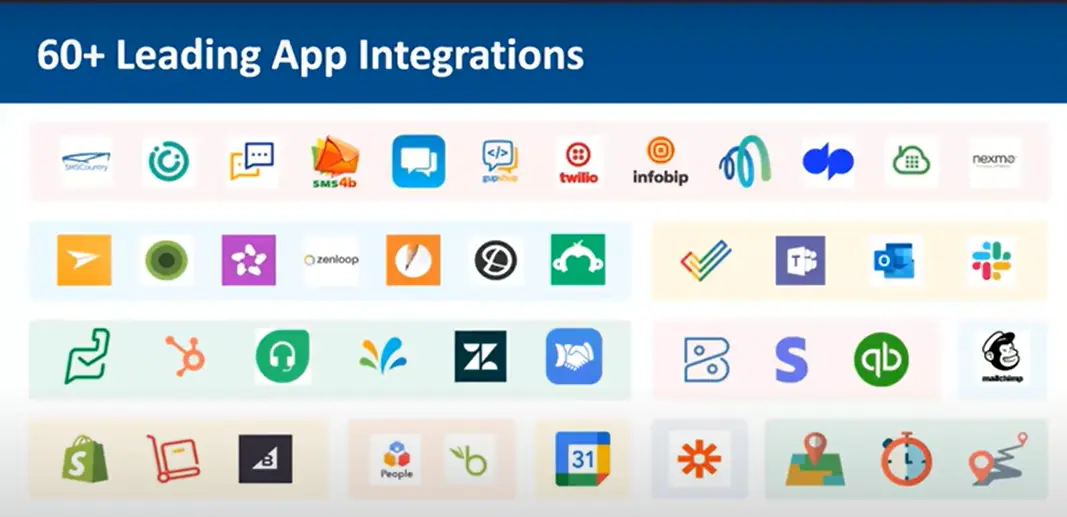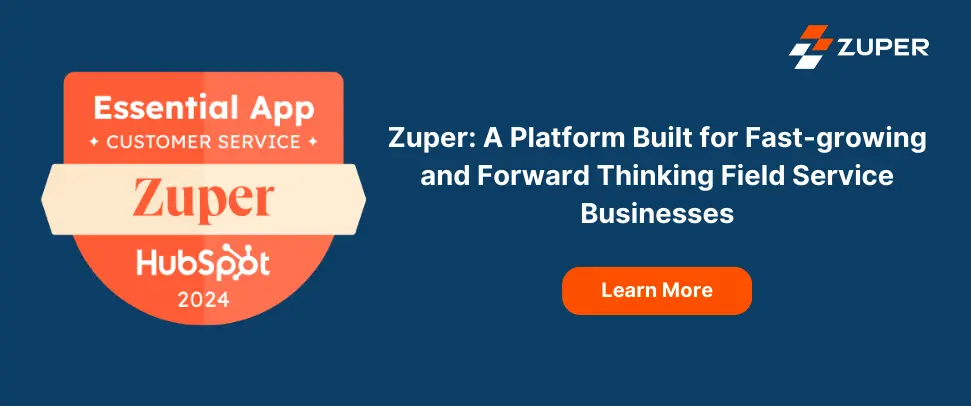The field service industry is awash with dynamic activity. Juggling technician schedules, managing work orders, and ensuring customer satisfaction can quickly snowball into a logistical nightmare. Thankfully, field service technology exists to streamline these processes, but with a plethora of options available, selecting the right solution can feel overwhelming. This comprehensive guide provides you with the knowledge and framework to navigate the field service technology landscape and choose the perfect tool for your unique needs.
We’ll delve into the functionalities offered by field service software (FSM), explore crucial factors for consideration, and provide a roadmap for successful implementation. By the end of this guide, you’ll be empowered to make informed decisions that optimize your field workforce, elevate customer satisfaction, and propel your business to new heights.
1. Examine their product capabilities for the level of advancement
Field Service Management (FSM) software acts as the central nervous system for your field operations, automating workflows, fostering real-time communication, and empowering data-driven decision-making. Here’s a breakdown of key features commonly found in FSM solutions, along with how each capability translates into actionable benefits for you:
Work order management
Imagine a world where work orders aren’t scattered across sticky notes and spreadsheets, a reality that plagues 62% of field service organizations according to a study by Aberdeen Group. FSM software centralizes work order creation, assignment, and tracking. You can create detailed work orders with specific instructions, parts requirements, and customer information. Automated dispatching algorithms consider technician skills, location, and real-time availability, ensuring the right person is sent to the right job. This eliminates manual dispatching headaches, reduces errors by an average of 33%, and optimizes technician utilization by 20%, according to a study by Frost & Sullivan. Additionally, real-time updates on work order progress keep you informed and allow for proactive communication with customers, boosting their satisfaction.
Scheduling and dispatching
Scheduling technicians efficiently is a constant battle for CTOs in the field service industry. FSM software provides a visual overview of technician schedules, appointments, and workloads. Drag-and-drop functionality allows for quick adjustments based on real-time updates. Dispatching becomes a breeze with features like automated skill-based matching and optimized routing. Optimized routing tools consider factors like traffic patterns and technician location to minimize travel time and maximize productivity. This translates to faster service delivery, improved customer satisfaction by 57% according to Zendesk, and reduced operational costs by up to 15% as reported by McKinsey & Company.
Invoicing
Gone are the days of chasing down invoices and manually calculating costs. FSM software streamlines the invoicing process by automatically generating invoices based on completed work orders. You can define billing rates, include parts and material costs, and generate invoices electronically for faster customer payments, improving cash flow by 18% as reported by Bill.com. Integration with accounting software eliminates tedious data entry and ensures financial records are always up-to-date. This not only saves valuable time but also reduces errors and improves cash flow.
Real-time location tracking
Imagine having a bird’s-eye view of your entire field workforce. FSM software with real-time location tracking empowers you with the ability to see technician location on a map. This provides valuable insights for optimizing routes, providing accurate estimated arrival times to customers, and ensuring technician safety. You can identify bottlenecks, reroute technicians in case of unforeseen delays, and proactively manage customer expectations. Real-time location tracking also fosters accountability and improves transparency within the team.
Mobile apps
Empower your technicians with the freedom and flexibility of mobile apps. FSM software often includes mobile applications that allow technicians to access work order details, customer information, and job history on the go. They can capture customer signatures electronically, collect payments on-site using secure payment gateways, and update job status in real-time. This eliminates the need for paper-based work orders and manual data entry, improving efficiency by 43% and reducing errors by 39% according to a study by Gartner. Mobile apps also enhance communication between technicians and managers, allowing for faster issue resolution and improved customer service by ensuring first-time fixes.
Inventory management
FSM software with inventory management capabilities empowers you to track inventory levels, monitor parts usage, and automate reordering processes. Real-time inventory visibility ensures technicians have the necessary tools and materials to complete jobs efficiently, boosting first-time fix rates by 17% according to Zebra Technologies. You can set reorder points to prevent stockouts and optimize inventory carrying costs by 12% as reported by IndustryWeek. This translates to improved customer satisfaction, reduced downtime for technicians, and enhanced overall operational efficiency.
Reporting and analytics
Data is king in the field service industry. FSM software provides comprehensive reporting and analytics tools that transform raw data into actionable insights. You can generate reports on key performance indicators (KPIs) such as technician productivity, job completion times, customer satisfaction ratings, and first-time fix rates. These reports help identify trends, pinpoint areas for improvement, such as technician skill gaps or inefficient routing patterns, and measure the effectiveness of implemented strategies. Data visualization tools present complex information in easy-to-understand formats, allowing you to make data-driven decisions that optimize field service operations and maximize return on investment (ROI).
2. Evaluate their fit for your business and budget
While features are crucial, choosing the right field service technology goes beyond a simple checklist. Here are key factors to consider during your evaluation process, along with how they impact your business:
Company size and needs
A one-size-fits-all approach doesn’t work in the field service industry. A large enterprise with hundreds of technicians and complex workflows will require a feature-rich, scalable solution. On the other hand, a smaller company with a handful of technicians may prioritize user-friendliness and affordability. Identifying your specific needs and challenges upfront will guide your selection process when choosing field service technologies. Evaluating solutions based on features that directly address your pain points ensures you get the most value out of your investment.
Budget
Field service technology solutions range in price depending on features, deployment options, and vendor reputation. Be realistic about your budget and avoid overspending on features you may not necessarily need. Prioritize functionalities that deliver the most significant ROI for your business. Consider exploring freemium models or solutions with tiered pricing structures to find the best fit for your budget constraints.
3. Identify how they maximize the value of field service software
We’ve now explored the functionalities of field service technology and the factors to consider when making your selection. Here’s a step-by-step guide to choosing the right solution, along with additional considerations for each step:
Define your needs
This step forms the foundation of your selection process. Conduct a thorough internal audit to identify current challenges and desired outcomes. What operational areas require improvement? Are you aiming to reduce administrative tasks by 50%, improve technician communication by 30%, or gain deeper insights into field service performance to boost first-time fix rates by 15%? Clearly defined goals will help you prioritize features and shortlist solutions that cater to your specific needs.
Research available options
Leverage online resources, industry publications, and software review platforms to research potential solutions. Shortlist a few vendors that seem to align with your budget and requirements. Look for vendors with a strong reputation in the field service industry and a proven track record of success in companies of similar size and complexity. Reading user reviews can provide valuable insights into real-world experiences with the software.
Request demos and free trials
Don’t just rely on brochures and marketing materials. Schedule demos with shortlisted vendors to experience their software firsthand. Take advantage of free trials to test drive the features and assess suitability for your team. Pay close attention to the user interface and ensure it’s intuitive for both dispatchers and technicians. Ask questions about specific functionalities, implementation processes, ongoing support options, and data security measures.
Evaluate user interface and usability
A user-friendly interface is paramount for successful software adoption. During demos and free trials, evaluate the software’s user interface and assess its ease of use. Consider the technical skillset of your team and prioritize solutions with intuitive navigation and minimal learning curves. Investing in software with a user-friendly interface not only minimizes training time but also fosters user adoption among technicians and dispatchers. This ensures everyone can leverage the software’s capabilities to their full potential, ultimately maximizing the return on your investment.
Consider integration capabilities
Field service operations rarely exist in isolation. Your FSM software should integrate seamlessly with existing business systems like CRM, accounting, and inventory management software. Seamless integration eliminates the need for manual data entry between different systems, reducing errors and streamlining workflows. It also ensures data consistency across your organization, providing a holistic view of customer interactions, financial performance, and inventory levels. Evaluate the vendor’s integration capabilities and inquire about available connectors or APIs (Application Programming Interfaces) to ensure compatibility with your existing software stack.

Prioritize security and compliance
Data security is a critical concern in today’s digital landscape. Customer information, work order details, and financial data entrusted to your FSM software require robust security measures. Choose a vendor that prioritizes data security and adheres to relevant industry regulations. Evaluate the vendor’s security protocols, including data encryption, access controls, and disaster recovery plans. Ensure the software complies with relevant data privacy regulations such as GDPR (General Data Protection Regulation) or CCPA (California Consumer Privacy Act) depending on your location and customer base.
Onboarding and implementation
Understanding the onboarding and implementation process is critical in selecting the right field service management (FSM) technology. It ensures a smooth user experience and maximizes the value of the software by equipping your team with the necessary skills through comprehensive training programs. Knowledge of the implementation process can help you identify potential areas where support may be needed, such as integrating the software with existing systems or training new users. In this way, onboarding and implementation are crucial in ensuring that support channels, response times, and SLAs meet your needs for successful software adoption.
Conclusion
Selecting the right field service technology is a strategic decision that can significantly impact your business. By following the steps outlined in this guide and carefully considering your specific needs, you can empower your field workforce, optimize operations, and elevate customer satisfaction. Remember, the ideal FSM software should be a perfect fit for your company’s size, budget, and operational goals. With a data-driven approach and a focus on user adoption, you can leverage FSM technology to propel your field service business toward greater heights.
Book a free demo of the most adaptable field service management solution.
Step up and be a force for good. For every T-shirt you wear, over 700 gallons of water is consumed. You hold the power to reclaim gallons of water with every garment you wear. Choose minimalism; Save water. Mindful closet for a sustainable future!





